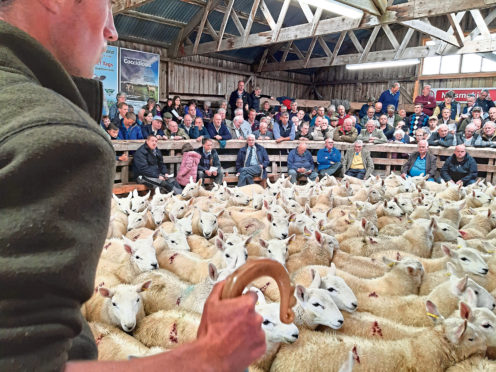Scotland’s sheep industry brushed aside dire predictions of post-Brexit annihilation yesterday and quietly got on with the business of selling and buying lambs at one of the country’s landmark sales.
The tiny hillside market on the outskirts of Lairg reverberated to enthusiastic bidding for wethers from all the regular lowland buyers as lambs from crofters and farmers from across the county met better-than-expected prices, although trade for ewe lambs became “pickier” later and fell well short of last year’s outstanding sale.
In total, 9,644 wether lambs averaged £52.07, up 96p on the year, while 3,474 ewe lambs averaged £59.51, down £17.03.
Sellers of wether lambs couldn’t hide their surprise or delight after months of prophesies by industry leaders that even the prospect of a no-deal Brexit would lead to collapsed prices and a new wave of Highland clearances.
In the industry’s favour this year is an abundance of lowland grass that needs to be eaten, together with record sheep prices in Australia and New Zealand.
Buyers of Lairg sheep have also enjoyed good returns on their investments over the last few years.
Lockerbie buyer Jim Reid from Bengal Farm aimed to take home around 700-800 lambs.
He paid prices similar to last year for 480 from Achentoul Estate, many of which will be destined for Europe in the spring, while the bigger sheep will be offloaded on to the market earlier.
“I’ll probably spend £40,000 at this sale and I’m slightly uneasy because we don’t know what February will bring,” he said.
“It’s probably optimism on my part. Some years we make quite a bit of money, other years we draw even, and one year we sold them for less than we bought them for.
“The price is always too dear if you’re buying, but if we don’t give the breeders a decent price the sheep won’t be there, and the economy of Lairg is based on sheep.”
St Andrews farmer George Milne bought 200 lambs which will be sold back through the United Auctions live ring in April or May.
“Markets might be difficult but we’ve got to keep trading as an industry,” he said.
“You can’t jump in or out in a year, you plan ahead, you buy lambs, that’s what you do. I believe we have to be positive.
“The lobbying organisations have talked about a support mechanism for the sheep sector and now is the time to get a commitment from the government that they will underpin the lamb price if we leave with no deal.”
Joyce Campbell from Armadale Farm sold 600 lambs to her regular buyers and said she was “very pleased and relieved” that prices for her ewe lambs were up on the year, while her wethers were slightly back on 2018.
NFU Scotland’s Less Favoured Areas committee chairman, Robert MacDonald, rejected any suggestion the union has been calling wolf over the consequences of a no-deal Brexit.
“The warnings had to be made because we are potentially looking at 40% tariffs on exports,” he said.
“The Lairg trade has been surprising and I had been anticipating the worst.
“There’s a lot of brave men around the ring and I hope their optimism will be justified when it comes to selling these lambs.
“I’m sure it will, and I hope for all our sakes that they come out the other side with a profit – whatever happens in October.”
nnicolson@thecourier.co.uk










